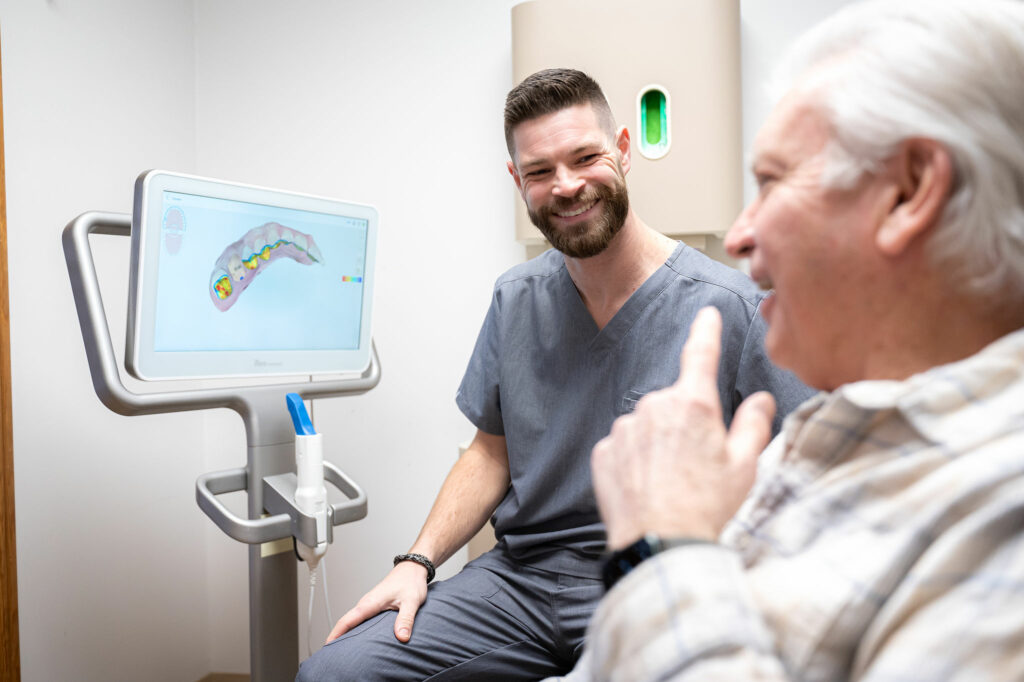General dentists handle routine dental care, while periodontists treat advanced gum and bone problems. Both play important roles in protecting your oral health, just at different stages and levels of care.
Who to see depends on the condition of your teeth, gums, and supporting structures. If you’re dealing with ongoing issues like gum disease, gum recession, or bone loss, understanding these roles can help you get the right care at the right time.
Here’s how they differ—and when to see each.

What Is a General Dentist?
A general dentist in Huber Heights is your go-to for routine dental care. They complete four years of dental school and are trained to diagnose, treat, and manage overall oral health. Most people start with a general dentist for cleanings, exams, and basic treatments.
Your general dentist may:
- Fill cavities
- Perform root canals
- Extract teeth
- Place crowns and bridges
- Manage early signs of gum disease
They’re also the ones who educate you on daily oral health care habits like brushing and flossing. Many people see their dentist twice a year for regular cleanings. It’s the first line of defense against tooth decay, gum problems, and other common conditions.
But when gum disease progresses or bone loss becomes an issue, that’s where a periodontist comes in.
What Is a Periodontist?
A periodontist in Huber Heights is a specialist who focuses on the prevention, diagnosis, and treatment of periodontal disease. They take the same base training as a general dentist but go on to complete an additional three years of education. During that time, they learn how to manage advanced gum and bone conditions.
Periodontists treat the structures that support your teeth—gum tissue and the underlying bone. If those structures begin to break down, it can lead to tooth loss. That’s why their job is so important to your long-term oral health.
You might see a periodontist for:
- Deep cleaning below the gumline
- Gum grafts for gum recession
- Bone grafting where bone has been lost
- Dental implants
- Surgical treatment for advanced gum disease
They help manage problems that go beyond what a standard cleaning or exam can address.
Comparing Roles: Periodontist vs Dentist
Both general dentists and periodontists aim to protect your oral health. But their focus and training are not the same.
A general dentist handles preventive and restorative care. They identify early signs of gum trouble and do small repairs. However, when gum disease causes serious infections or structural damage, a periodontist steps in for a more targeted approach.
Here’s a simple comparison:
| Task | General Dentist | Periodontist |
| Routine checkups | ✅ | X |
| Fillings and crowns | ✅ | X |
| Gum disease treatment (early stage) | ✅ | ✅ |
| Gum disease (advanced) | X | ✅ |
| Gum grafts | X | ✅ |
| Bone loss treatment | X | ✅ |
| Dental Implants | X | ✅ |
Signs You May Need a Periodontist
Sometimes the signs are obvious. But gum disease can also build quietly over time.
Watch for these signs that may need closer attention than your general dentist can give:
- Gums that bleed during brushing or flossing
- Chronic bad breath that brushing doesn’t fix
- Receding gums that expose more tooth surface
- Loose teeth or changes in the way your bite fits together
- Bone loss visible on X-rays
- Difficulty chewing due to sensitive or shifting teeth
These signs could suggest moderate to advanced periodontal disease. It’s not about avoiding your general dentist—it’s about getting the right care level at the right time.

What Is Periodontal Disease?
Periodontal disease is a serious infection of the gum tissue and surrounding bone. It starts when plaque builds up and isn’t removed with regular brushing and professional cleanings. Over time, the bacteria can move below the gumline.
The early stage is gingivitis, and it can usually be reversed with solid dental hygiene and care. But if it progresses to periodontitis, the damage becomes harder to reverse. Without treatment, it can lead to gum recession, bone loss, and eventually, tooth loss.
Periodontal treatment from a specialist can stop that damage and help restore your gum health. That’s why early intervention makes a big difference.
Treatment Options a Periodontist Offers
Periodontists provide advanced care when gum disease progresses beyond what general dental care can manage. Their treatments focus on restoring gum health, halting further damage, and preserving the integrity of your teeth and jawbone.
Here are some of the most common treatments periodontists perform:
Scaling and Root Planing
Scaling and root planing is a non-surgical deep cleaning procedure used to treat early to moderate periodontal disease. The periodontist carefully removes plaque and hardened tartar (calculus) from below the gumline. After scaling, the tooth roots are smoothed through a process called planing. This helps the gums reattach to the clean surfaces and reduces pocket depth.
Gum Grafting
Gum grafting repairs areas of gum tissue that have receded due to periodontal disease. Recession can expose sensitive roots, increase your risk of tooth loss, and make your teeth appear longer.
During the procedure, the periodontist takes healthy tissue—either from your palate or a donor source—and grafts it to the affected area. This adds thickness to the gums, protects tooth roots, and improves the appearance of your smile.
Gum grafting is often recommended when teeth become overly sensitive or when recession threatens tooth stability.
Bone Grafting
Bone grafting replaces or rebuilds areas of bone that have been destroyed by periodontal disease. Bone loss can weaken the support structure for your teeth and make it difficult to place dental implants in the future.
A periodontist uses natural or synthetic grafting material to stimulate new bone growth. This encourages the body to regenerate bone in places where it has deteriorated.
Over time, the graft helps anchor teeth more securely and can restore jawbone volume lost to infection or tooth loss.
Dental Implants
Dental implants are surgical replacements for missing teeth. A periodontist places a titanium post into the jawbone, where it acts as an artificial tooth root. Over time, the surrounding bone fuses to the implant in a process called osseointegration. And then once the bone has healed, a crown or prosthetic tooth is attached.
Periodontal Surgery
When gum disease is advanced, non-surgical treatments may not be enough. Periodontists may perform flap surgery or other procedures to reduce pocket depth around the teeth. By lifting the gums, cleaning underneath them, and repositioning the tissue, they allow easier access for future cleanings and help reduce bacterial buildup.
Surgical treatment may also involve reshaping the bone or removing infected tissue to support healing. These procedures aim to stabilize the teeth and help prevent further damage from chronic infection.

Choose the Right Professional for the Right Problem
General dentists and periodontists handle different parts of dental care. A general dentist manages routine cleanings, early gum concerns, and common dental procedures. A periodontist treats complex issues like gum disease, gum recession, and bone loss—and places dental implants when teeth can’t be saved.
If you notice signs like bleeding gums, persistent bad breath, or shifting teeth, mention them at your next visit. These issues can lead to tooth loss if ignored.
Your dentist may continue care or refer you to a periodontist, depending on what you need. Both work toward the same goal: keeping your teeth stable and your gums healthy over time.
